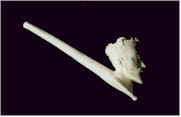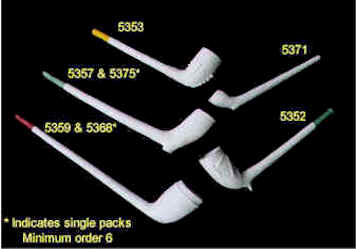Pollock Clay Pipes: Difference between revisions
(New page: From [http://www.sheffieldexchange.com/pipesand.htm Sheffield Exchange] the US and Canadian Distributor for Pollock Clay Pipes: The introduction of tobacco from American Indians also bro...) |
No edit summary |
||
| Line 1: | Line 1: | ||
From [http://www.sheffieldexchange.com/pipesand.htm Sheffield Exchange] the US and Canadian Distributor for Pollock Clay Pipes: | [[Image:pollockclaypipes2.jpg|right|]]From [http://www.sheffieldexchange.com/pipesand.htm Sheffield Exchange] the US and Canadian Distributor for Pollock Clay Pipes: | ||
The introduction of tobacco from American Indians also brought the clay pipe to England in the mid-1500's. The simple bowl, whose size changed in relation to the cost and availability of tobacco, evolved into a work of art. | The introduction of tobacco from American Indians also brought the clay pipe to England in the mid-1500's. The simple bowl, whose size changed in relation to the cost and availability of tobacco, evolved into a work of art. | ||
Revision as of 17:53, 31 July 2007
From Sheffield Exchange the US and Canadian Distributor for Pollock Clay Pipes:
The introduction of tobacco from American Indians also brought the clay pipe to England in the mid-1500's. The simple bowl, whose size changed in relation to the cost and availability of tobacco, evolved into a work of art.
John Pollock & Company of Manchester, England began making clay pipes in 1879 and continued until Gordon Pollock's retirement in 1992. Not wanting to see such a classic tobacco art form end, Wilsons & Company purchased the molds and the Pollock name, continuing the legendary art of clay pipe making. Many of the original hand-pressed molds are still in use.
Clay pipes are not only great collectibles but will allow any pipe connoisseur the purest taste of tobacco flavor:

